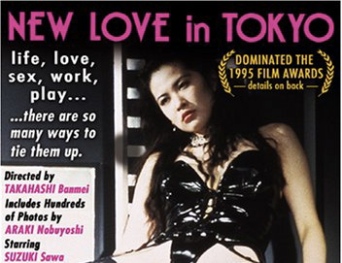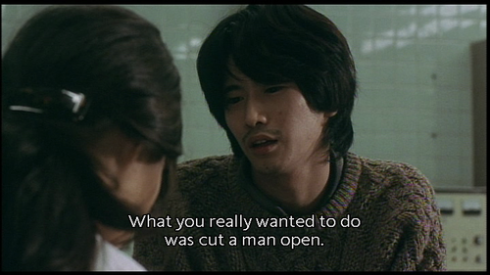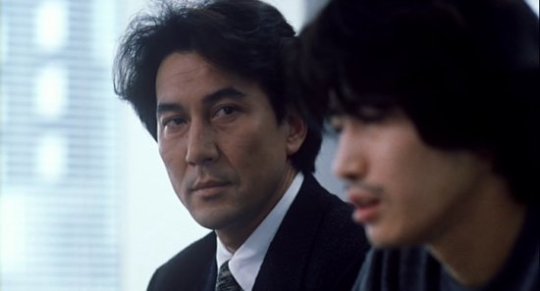Although the 1980s were equally an era of conservative and historically themed films for the Japanese (see Akira Kurosawa’s Ran and Kagemusha, which captured the attention of international audiences by retelling age-old morality tales, or Miyazaki’s early stories of heroism and 1985’s appealing comedy Tampopo), they were more important as a springboard for the prolific Japanese film industry of the 1990s.
In the early 1990s, between the introduction of the multiplex and the new frontier of the direct-to-video market, Japan saw a major economic reversal in its film industry—one that would eventually come to have a profound impact on unsuspecting American audiences. While the pink (in other words, porno) and genre horror directors of the ‘80s found lucrative results in the wild west of Japanese V-Cinema (video cinema), big studios like Toho could dominate the movie theater market with their own blockbusters.
Enter Kiyoshi Kurosawa, a veteran filmmaker on the cusp of his 40s, marooned in the V-Cinema of 1990s Japan. A commercial filmmaker in the purest sense of the word, he was the kind of director valued, rather than demonized, in the economic climate of late ‘80s and early ‘90s Japan. In the past, he’d endured a four-year blacklisting from major industry powers after a falling out with the esteemed Banmei Takahashi over Kurosawa’s pink film debut; in an amusing turn of events, Kurosawa had naively tried to turn his Nikkatsu exploitation flick into a Hitchcockian mystery film.
Prior to the release of 1997’s Kyua (Cure), Kurosawa’s last theatrical release had been the 1991 slasher The Guard from Underground. In the early 1990s he had received a scholarship from the Sundance Institute on the basis of his un-filmed script Karisuma (Charisma), and thus, in an act equally characterized by humility as by enthusiasm, traveled to study filmmaking in the United States—despite having already possessed ten years of professional experience.
“…I should confess that my personal relationship with Japanese filmmakers of the past is a distant one,” said Kurosawa in a 2001 interview with The Village Voice. “…My interactions with film history have been heavily influenced by American cinema and by Jean-Luc Godard.” He continued to outline how his appreciation of American cinema fell in line with his own pragmatic film-making philosophy, claiming that “the act of film-making itself” should be reason enough to make a movie. As a matter of fact, Kurosawa’s interviews nearly always contain a reference to his admiration of American cinema. When approaching any of his films, but particularly Cure, understanding the filmmaker’s relationship with the classics of American cinema is integral.
It is pretty obvious that Kurosawa was not aiming for the commercial jugular when he returned to Japan to film Cure, as he had so dutifully done in his V-Cinema days. Rather, Cure was a bleak, pitch-black, and existential film, whose ability at drawing in mainstream audiences would have to rely on good marketing… or, maybe, the strictly incidental occurrence of one of the most important events in the history of international cinema.
In 1998, Hideo Nakata bewildered Japanese audiences with his nihilistic, spiritually deprived horror film, Ringu. It exploited a brilliantly effective premise: what if the television, the ultimate source of artificial company and a staple of contemporary lifestyle, could become society’s worst nightmare? Ringu was one of the most important horror films of all time, because it effortlessly blended the omnipresent dread of the slasher, the intrigue of the classic ghost flick, and, most importantly, the exploitation of the disaster film. By the time Ringu was remade in the United States as The Ring (2002), American demand for this new, exotic brand of fear had begun to peak.
It’s not like Cure was as successful as Takashi Shimizu’s Ju-on (1998) or Takashi Miike’s Audition (1999) at accidentally fulfilling the growing American appetite for “J-horror”, as it had come to be known, but it certainly didn’t hurt Kurosawa’s film, which, at least superficially, bore all the defining marks of a Japanese horror film. By the end of the ‘90s Kurosawa was a darling of the international “art-house” community, mostly due to Cure.
It begins with a young woman and a doctor, occupying one of Kurosawa’s distinguishable long takes. The doctor hands the woman a book, from which she reads an excerpt; the book is a novelized version of the story of Blue Beard. There is a brief earthquake, which the two behold wordlessly and passively. “I know how the story ends,” the woman tells her doctor after returning the book to him. Sympathetically, he humors his patient. “The daughter kills Bluebeard,” she says.
Cure follows a detective by the name of Takabe (Koji Yakusho); it’s a role that seems to be one that Yakusho was born for. Although Cure was Yakusho’s first collaboration with Kurosawa, the popular actor became a regular for the filmmaker, eventually appearing in the lion’s share of Kurosawa’s films (and almost always playing the same kind of character). “[Yakusho and I] belong to the same generation,” Kurosawa explained in an interview with Cinespot. “We are basically the ‘in between’ generation, and we do share a certain perspective of the world—that is, we both feel how unstable the future is.”
The “in between” generation that Kurosawa mentions refers to the one shoulder-to-shoulder with the “politically engaged” WWII generation and the young Otaku generation that has, in the 21st century, come to redefine Japanese culture for westerners. And, if ever a film was made with this complacent, realist “in between” generation in mind, Cure is a fine example—a film populated by the vanilla, 30-something middle class, whose world is turned upside down by the rude awakening of a horrific social crisis.
The film focuses, in the beginning, on the efforts of Takabe to uncover the mystery surrounding a string of connected murders, wherein the killer carves an ‘X’ into their victim’s chest, and then exhibits signs of amnesia and shock upon arrest. We’re introduced to Mamiya (Masato Hagiwara), an apparent amnesiac who drives his victims to murder through hypnotism. After Mamiya is apprehended, the rest of the film deals with Takabe’s attempting to understand Mamiya and his confrontation with the hypnotist. Takabe, with the help of a police psychologist, comes to understand that Mamiya practices the techniques of the 19th century psychic Mesmer, persuading his victims to realize their most violent, uninhibited desires through the “power of suggestion”. Takabe fascinates Mamiya, for he seems impossible to hypnotize; nonetheless, the influence of the hypnotist causes Takabe to wrestle with his sanity. We see the process of Mamiya’s persuasion unravel through Takabe’s eyes, as the detective begins to fantasize about the death of his burdensome and mentally unstable wife.
A masterpiece of sustained atmosphere, Cure is a clinical, self-distanced thriller, which, by nature, sounds paradoxical; it should be assumed that a thriller would be as self-involved as possible, as it is relentlessly attempting to invest the viewer’s active intrigue in the plot. But Kurosawa is able to make a more engaging film by limiting the action as much as possible.
His style consists of long takes stacked against each other; dialogue is portrayed in an old fashioned manner, with characters speaking within the same frame—meaning minimal cutting. Through this method, Kurosawa is able to add importance to an event by using one of his rare close-ups, or, due to the lack of musical queues, inserting a sudden swell of ominous tones.
A perfect example of either technique is the scene in which the occult hypnotist Mamiya influences his first victim. In the victim’s shadowy, claustrophobic beach house, Mamiya and the man trade off dialogue—Mamiya asking his bizarre questions, and the hapless, bewildered man answering the best that he can. The atmosphere is immense from the beginning of the scene, but Kurosawa amplifies the tension when Mamiya introduces the flame, an important symbol in the film and the hypnotist’s key vehicle for ensnaring his victims. This disorienting shot corresponds perfectly with a deep, ambient queue.
Cure is, above all else, social commentary. Thematically, it is an incredibly dense film, as each of the murders depicted tackles a different societal issue—there is the husband who murders his loyal wife; the oppressed, discriminated female physician who tears off the face of a patient; the police officer who ventilates his partner. Meanwhile, the relationship between Takabe and Mamiya is the film’s central philosophical conflict. Takabe, a detective and therefore by nature an enforcer of boundaries and the general maintenance of society, must confront Mamiya, a criminal who has dedicated himself to the removal of the very boundaries that Takabe is required to uphold.
Kurosawa claims to be influenced primarily by the work of Hollywood veteran Don Siegel. Cure—as well as most of Kurosawa’s films—is remarkably comparable to either version of Siegel’s classic, Invasion of the Body Snatchers (1956; 1978). Aside from the dry, ominous style, Kurosawa takes influence from the films’ examination of social phenomena; in Cure, a nihilistic hypnotist replaces the body snatchers, but the effect taken on society is similar. Kurosawa would come even closer to Siegel’s film in what would become his most well known work, 2001’s Kairo (Pulse), a film about ghosts invading the world of the living.
But where Siegel was dissecting first the American fear of communism, and then, in 1978, the American fear of social complacency, Kurosawa reconstructs the American genre film to examine a distinctly Japanese theme: emotional repression. The eponymous “cure” is in fact a cure from socially binding constructs (i.e., in the three murders that take place between the film’s beginning and end, marriage, civil service, and gender). Japan, known internationally for its valuing of politeness, dignity, and respect, is, in the film, torn apart (although on a small scale, since Takabe presumably prevents the eventual apocalypse) by “curing” of each of Mamiya’s victims. The concept is not only presented through the murders, Takabe and Mamiya’s interactions, or the long expositions of the police psychologist, but also in more subtle moments. The strained interactions between Takabe and his wife (who, we learn, Takabe subconsciously wants dead), the hushed, depraved ramblings of a man waiting for his overdue dry-cleaning; Kurosawa peppers his script with the mundane non-events of everyday life, which, as the film suggests, are underlined by violent, primal desires.
It is not as if Mamiya’s hypnotisms would, by nature, have to incite murder; but the point of the film is that they do. Its conclusion is that humanity is inherently evil, and that society is, at best, a faltering attempt at concealing this malevolence. If we are to rely only on what the film shows us, it can be assumed that all Mamiya does is put his victims into a trance and ask them bizarre questions. When Mamiya is performing his routine, he takes the position of an ignorant child, asking people why they go to sleep, why they work, why they take orders from others. The only reason that such questions are able to drive his victims to insanity is because they are questions unanswered by the maddeningly convoluted nature of society. In the film, society is offered a cure, but due to mankind’s corruption, the effect is the reverse of what we typically think a cure should accomplish. Perhaps Mamiya was a kind of Marxist, convinced that a violent coup d’état, while eliminating most of the population, would create a utopia in its aftermath.
The film’s performances are exceptional. Yakusho and Hagiwara’s scenes together brim with tension, giving the film the epic conflict that it needs to succeed in delivering its message. Both realize their roles perfectly, Yakusho exploding with rage when he is not disillusioned and dreary, and Hagiwara, having “cured” himself, being serenely Zen-like and complacent. In the end, after Takabe enshrines the malevolence of society by murdering Mamiya himself, Yakusho’s subtle handling of the ambiguous final scene allows the audience to project their own interpretation as to the meaning of the film’s resolution.
Cure was screened at the Tokyo International Film Festival upon its completion in 1997. A critical, as well as a modest commercial success, the film made it overseas just in time to satisfy the budding Ringu zeitgeist in 1998, “[touring] the world’s film festivals” that same year.
Japanese film expert and longtime Kurosawa proponent Tom Mes described Cure as a case of the right place and right time: “It arrived at a moment when the serial killer film had become a Hollywood mainstay thanks to The Silence of the Lambs and Seven, and audiences were growing accustomed to cryptic supernatural tales that refused to disclose their secrets from their weekly dose of The X-Files,” wrote Mes in his review of the film. “But with its razor sharp dissection of the ills of contemporary life, Cure also offered a lot more than atmospheric psycho scares.”
The success of Cure allowed for Kurosawa to finally realize his decade-old script, Charisma—albeit with some limitation. As he explains in an interview for the DVD release’s special features, Kurosawa was forced to film in the dry forests at the base of Mt. Fuji, rather than in the Taiwanese jungle, as he had originally planned. An equally dense and strange film, Charisma also starred Yakusho, and examined society’s self-distancing from nature; this time, a giant tree, named “Charisma”, replaced the body snatchers. It remains Kurosawa’s strangest film apart from 2005’s utterly oddball mummy-caper-turned-romance Loft, being a sort of post-modern western equal part mystery-thriller and absurdist comedy.
“I didn’t intend [Charisma] as a Cure sequel at all,” Kurosawa explained in an interview with Midnight Eye. “But then having made Cure with Yakusho-san and then having cast him again in Charisma I guess it sort of naturally developed that way.”
Kurosawa didn’t stop making wonderful, distinct, and intellectually stimulating genre films. In 2001, under his biggest budget yet, he wrote and directed the brilliant Kairo (Pulse), a film that remains the ultimate examination of the Internet’s effect on modern society (it was later shoddily and ineptly remade by Wes Craven in America under the same title). The television film Séance (2000) was perhaps his finest honing of the genre film, as it was a remake of the tightly plotted British caper Séance on a Wet Afternoon (1968). After 2003’s Doppelganger (a black comedy designed specifically for Yakusho to play two roles), as well as the drama Bright Future that same year, and the previously mentioned Loft, Kurosawa said farewell to J-horror with the stunning deconstruction Sakebi (Retribution) in 2006. A film equally similar to Cure as it was Séance and Pulse, it once again employed Yakusho as the world-weary detective.
Following a four-year hiatus, Kurosawa returned to international attention with 2009’s disturbing familial drama, Tokyo Sonata. Reprising Bright Future’s examination of Japan’s generational gap while also examining the massive economic downturn of the time and the disintegration of the nuclear family, the film won Kurosawa his first official selection at the Cannes Film Festival.
True to his prolific outturn, Kurosawa currently has three completed projects awaiting western release: the crime mini-series Penance, the sci-fi thriller Real, and the mystery Seventh Code.








